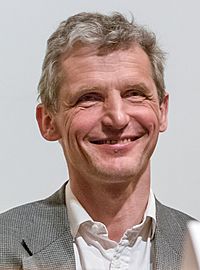Wolfgang Ketterle facts for kids
Quick facts for kids
Wolfgang Ketterle
|
|
|---|---|

Ketterle at a symposium at Brown University, 2007
|
|
| Born | 21 October 1957 |
| Nationality | Germany, United States |
| Alma mater | University of Heidelberg Technical University of Munich University of Munich Max Planck Institute of Quantum Optics |
| Known for | Atom laser Bose–Einstein condensates Spinor condensate |
| Awards | I. I. Rabi Prize (1997) Dannie Heineman Prize (1999) Fritz London Memorial Prize (1999) Benjamin Franklin Medal (2000) Nobel Prize for Physics (2001) Order of Merit of Baden-Württemberg (2002) |
| Scientific career | |
| Fields | Physics |
| Institutions | University of Heidelberg Massachusetts Institute of Technology |
| Doctoral advisor | Herbert Walther Hartmut Figger |
| Doctoral students | Martin Zwierlein |
Wolfgang Ketterle, born on October 21, 1957, is a German physicist. He is a professor of physics at the Massachusetts Institute of Technology (MIT). His work involves trapping and cooling atoms to super cold temperatures. These temperatures are very close to absolute zero, the coldest possible temperature.
In 1995, he led one of the first teams to create something called a Bose–Einstein condensate. This is a special state of matter that happens at extremely low temperatures. For this important discovery and his early studies of these condensates, he won the Nobel Prize in Physics in 2001. He shared the prize with Eric Allin Cornell and Carl Wieman.
Contents
About Wolfgang Ketterle
Wolfgang Ketterle was born in Heidelberg, Germany. He went to school in Eppelheim and Heidelberg. In 1976, he started studying at the University of Heidelberg. Two years later, he moved to the Technical University of Munich. He earned his master's diploma there in 1982.
His Early Research and Studies
In 1986, Ketterle earned his PhD in experimental molecular spectroscopy. This means he studied how light interacts with molecules. He did this research at the Max Planck Institute for Quantum Optics. After his PhD, he continued his research there and at the University of Heidelberg.
In 1990, he joined a research group at MIT in the United States. He became a physics professor at MIT in 1993. Since 1998, he has been the John D. MacArthur Professor of Physics. He also helps lead MIT's Center for Ultracold Atoms.
Key Discoveries in Physics
After creating Bose–Einstein condensation in 1995, his team made more breakthroughs. In 1997, they showed how two colliding condensates could interfere with each other. They also created the first "atom laser." This is like a regular laser, but it uses atoms instead of light.
Ketterle's team continues to study Bose–Einstein condensates. In 2003, they created a molecular Bose condensate. In 2005, they found evidence for "high-temperature" superfluidity. This is a state where a fluid can flow without any resistance.
Ketterle's Other Interests
Wolfgang Ketterle is also a runner. He was featured in "Runner's World" magazine in 2009. He talked about running in Stockholm when he received his Nobel Prize. He completed the 2013 Boston Marathon in 2 hours, 49 minutes, and 16 seconds. In 2014, he ran his fastest marathon in Boston, finishing in 2 hours, 44 minutes, and 6 seconds.
Ketterle helps guide the Center for Excellence in Education (CEE). He also gives talks to high school students in a program called the Research Science Institute (RSI). His own son, Jonas, attended this program in 2003. Ketterle also advises an Australian research center focused on future electronics.
In 2008, Ketterle and other Nobel Prize winners signed a letter. They asked President George W. Bush to provide more funding for science research. They wanted to support the United States Department of Energy's Office of Science, the National Science Foundation, and the National Institute of Standards and Technology.
Family Life
Wolfgang Ketterle married Michèle Plott in 2011. He has five children. Three of his children are from his previous marriage to Gabriele Ketterle, which lasted from 1985 to 2001.
See also
 In Spanish: Wolfgang Ketterle para niños
In Spanish: Wolfgang Ketterle para niños

